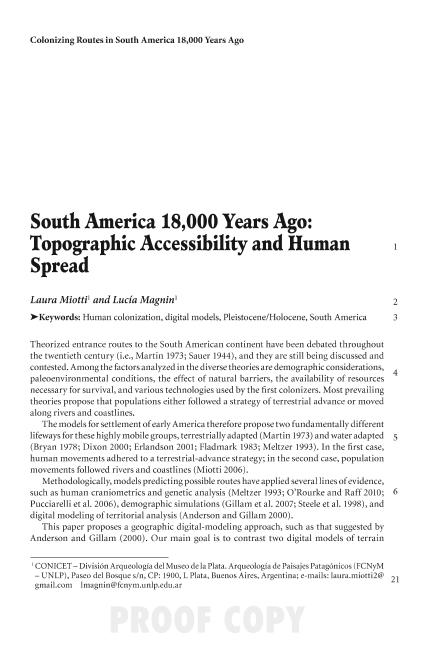Artículo
South america 18,000 years ago: Topographic accessibility and human spread
Fecha de publicación:
10/2012
Editorial:
University of Texas A&M. Department of Anthropology. Center for the Study of the First Americans
Revista:
Current Research in the Pleistocene
ISSN:
8755-898X
Idioma:
Inglés
Tipo de recurso:
Artículo publicado
Clasificación temática:
Resumen
Theorized entrance routes to the South American continent have been debated throughout the twentieth century (i.e., Martin 1973; Sauer 1944), and they are still being discussed and contested. Among the factors analyzed in the diverse theories are demographic considerations, paleoenvironmental conditions, the effect of natural barriers, the availability of resources necessary for survival, and various technologies used by the first colonizers. Most prevailing theories propose that populations either followed a strategy of terrestrial advance or moved along rivers and coastlines. The models for settlement of early America therefore propose two fundamentally different lifeways for these highly mobile groups, terrestrially adapted (Martin 1973) and water adapted (Bryan 1978; Dixon 2000; Erlandson 2001; Fladmark 1983; Meltzer 1993). In the first case, human movements adhered to a terrestrial-advance strategy; in the second case, population movements followed rivers and coastlines (Miotti 2006)...
Palabras clave:
GIS
,
Human Peopling
,
Latin America
,
Digital models
Archivos asociados
Licencia
Identificadores
Colecciones
Articulos(CCT - LA PLATA)
Articulos de CTRO.CIENTIFICO TECNOL.CONICET - LA PLATA
Articulos de CTRO.CIENTIFICO TECNOL.CONICET - LA PLATA
Citación
Miotti, Laura Lucia; Magnin, Lucia Angelica; South america 18,000 years ago: Topographic accessibility and human spread; University of Texas A&M. Department of Anthropology. Center for the Study of the First Americans; Current Research in the Pleistocene; 10-2012; 19-24
Compartir




